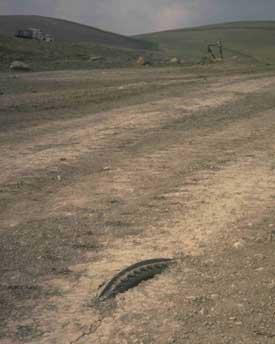Unsolved Landfill Mysteries—The Case of the Floating Tire

When I first started in the landfill business, one of the first bits of insider information I received was that tires float ... right up out of the landfill. And I suppose that if you've been in the landfill business for any length of time, you've probably heard a similar tale. Floating tires. Yeah sure.
Yet after working at the landfill for a while, I saw it myself. Tires in a landfill were like Joe Lewis in the ring, they just wouldn't stay down.
Now this isn't to suggest that it's some kind of alien plot. It isn't some kind of mystery that goes against the rules of modern science. Nor is it, as I heard one person suggest, that the tires eventually fill up with landfill gas and float to the surface like a hot-air balloon. But the fact is, if they are placed near the surface of the landfill, some of them will, in time, emerge.

It's simply that tires, being flexible and rubbery (duh, Bolton, they're made out of rubber), will spring back into shape after being compressed. And, if they're near the surface and surrounded by materials that are less springy, they can tend to work themselves upward.
Build a "Floating Tire" Simulator
Picture this ... or if you're a hands on kind of person, go ahead and do it: Place a soft rubber ball (like a tennis ball) in a bucket, then cover it with little scraps of paper, leaves and dirt. Cover the ball to a depth of 3-4 inches. Then tamp everything down with the end of a 2 x 4. Guess what, after a little "compaction" the ball will pop to the surface. So will tires.
No, tires won't climb 10 feet through compacted garbage like baby turtles headed for the ocean. But depending on the type of waste, type and size of tire, depth of burial, and amount of compaction/traffic, tires can certainly come to the surface.
Based on these factors, tires often emerge on sideslopes. On sideslopes, waste is often less compacted, thus tires have an easier time getting out. Also, the process of placing, grading, and compacting cover soil will increase the chance of tires emerging.
Similarly, tires will often emerge through haul roads that cross the landfill. The repetitive tamping or "pumping" caused by traffic will often bring tires to the surface. Heavy vehicles (i.e., scrapers) are more likely to expose tires than light traffic.
Minimizing the Problem
If you want to minimize the problem with floating tires, here are some ideas:
Neal Bolton, a registered engineer, author of "The Handbook of Landfill Operations," and principal of Blue Ridge Services, provides operational consulting for landfills in the U.S. and abroad. He can be reached at blueridge@blueridgeservices.com.
